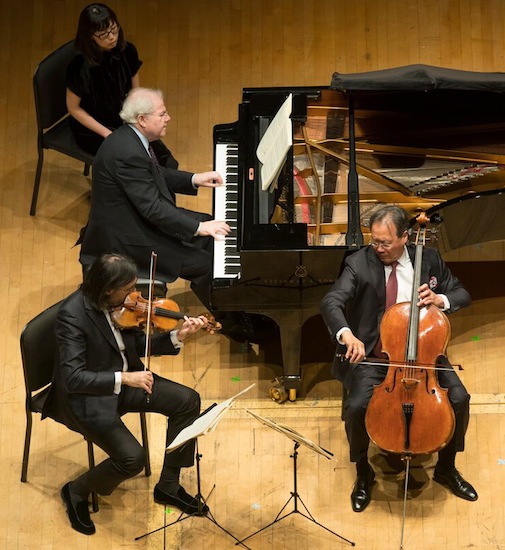Early Brahms proves best from Ma, Ax and Kavakos

There are not many musicians these days who can pack Orchestra Hall to the rafters for an afternoon of chamber music. But bring cellist Yo-Yo Ma and pianist Emanuel Ax together–along with violinist Leonidas Kavakos–for an afternoon of Brahms’ complete piano trios and suddenly classical music becomes a sporting event with the audience overflowing to substantial stage seating.
Ma and Ax are, of course, longtime Brahms collaborators both live and on disc. The duo recorded the Brahms’ Cello Sonatas 33 years ago as well as the Piano Quartets with Isaac Stern and Jaime Laredo.
Ma and Ax have finally gotten around to the Brahms piano trios. Along with Kavakos they have recently released a set of all three works on Sony and are embarked on a national tour, which brought them to Chicago on Sunday.
The program’s non-chronological order of battle (Nos. 2, 3 and 1) offered a sort-of dramatic arc, going from darkness, to more darkness and then light. As it turned out the program also paralleled the success of the performances with the last-played First Piano Trio providing the highlight of the afternoon.
As on their recent Sony release, the middle work, Trio No. 2 in C major, which led off the afternoon, proved the most elusive. Opus 87 marks a concise midway point between the framing works in the genre, with taut drama balanced against songful passages.
There were inspired moments with Ma’s warm, singing tone and Ax’s sturdy pianism making a contrasting foil for Kavakos’s more quirky unsentimental style. The string players blended gratefully for the Andante’s pensive meditation as well as a lovely rendering of the Scherzo’s trio to contrast the ghostly skittering of the main theme.
But there were also prosaic and unconvincing passages where the musicians didn’t seem in synch with the music. The tempo for the opening Allegro was deadly even by the tradition of taking Brahms’ Allegros at a stately pace. A static quality dominated with the abrupt accelerations and decelerations–one suspects this was Kavakos’s influence–making it seem like the musicians were pushing and pulling at the score rather than simply performing it. The finale went with galumphing energy though here too, amid the intermittent herky-jerky effects, a more straightforward approach would have better served the music.
Kavakos was much more restrained and collegial than he often can be in his concerto performances, which I’ve found uneven. (The Greek violinist will be back in town next week to play Shostakovich with the CSO.) Still, one couldn’t help feeling at times Kavakos was influencing his older colleagues to tone down their warmer, more traditional Brahms approach without always having something convincing to substitute in its place.
Regardless, the musicians seemed more at home in the Trio in C minor, Op.101. The restless drama of this work puts the lie to the canard that all of Brahms’ late music is “autumnal” and ruminative in character. The turbulent drama of this music was manifest throughout the fist movement, the players nicely capturing the uneasy dancing quality of the Presto as well. In the Andante grazioso Kavakos and Ma brought a piquant, almost Rococo character to the main theme, rather than the usual heavy vein of sentiment. The nervous agitation of the finale was put across with due energy and power.
And so, to the Piano Trio No. 1 in B major, Op.8, after intermission. This most expansive and lyrical of the set also received the most rewarding and lived-in performance. There was no fussiness or over-thinking the music, with Ma’s beautifully burnished solo in the opening pages setting the communicative tone. Here there was an organic ebb and flow throughout, the stormy and lyrical elements held in a dexterous balance, with all three players luxuriating in a golden, drawn-out coda to the first movement.
The Adagio brought the finest playing of the afternoon—taken at a daringly spacious tempo yet skillfully sustained, the musicians conveyed a fragile, searching expression, maintaining intense concentration even with a bevy of unmuffled, hacking coughs.
The ovations and applause were resounding and even after a long afternoon of music, the packed house insisted on an encore. Ma, Ax and Kavakos obliged with the Andante con moto tranquillo from Mendelssohn’s Piano Trio No. 1 in D minor, rendered with confiding intimacy and melting tenderness.
Posted in Performances




